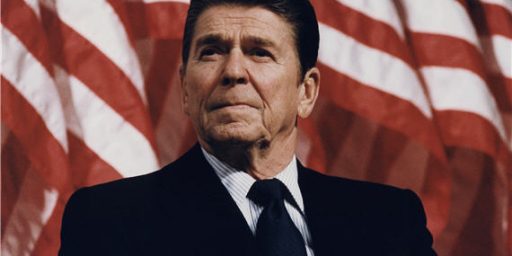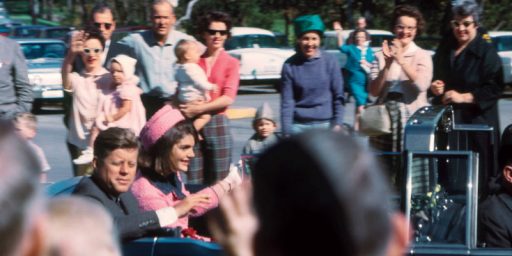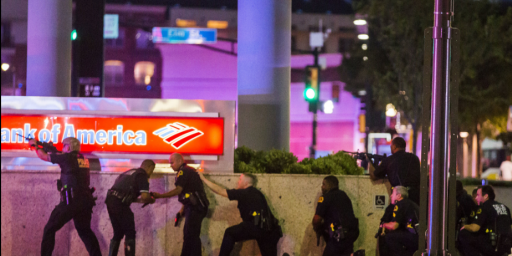Kennedy Assassination Story
A stark account of how American journalism has changed over the last half century.
Ivo Daalder just tweeted out the New York Times account of the assassination of President John F. Kennedy by Tom Wicker, noting it was his “break-through story.” Reading it gives a stark account of how American journalism has changed over the last half century.
Here’s the headline followed by the two sub-heds:
KENNEDY IS KILLED BY SNIPER AS HE RIDES IN CAR IN DALLAS; JOHNSON SWORN IN ON PLANE
Gov. Connally Shot; Mrs. Kennedy Safe
President Is Struck Down by a Rifle Shot From Building on Motorcade Route–Johnson, Riding Behind, Is Unhurt
Remarkably succinct and informative. The reader has all the pertinent information just from those blurbs. Now, most headlines and subheads are designed to attract and tease.
Here are the opening ‘graphs:
President John Fitzgerald Kennedy was shot and killed by an assassin today.
He died of a wound in the brain caused by a rifle bullet that was fired at him as he was riding through downtown Dallas in a motorcade.
Vice President Lyndon Baines Johnson, who was riding in the third car behind Mr. Kennedy’s, was sworn in as the 36th President of the United States 99 minutes after Mr. Kennedy’s death.
Mr. Johnson is 55 years old; Mr. Kennedy was 46.
Shortly after the assassination, Lee H. Oswald, who once defected to the Soviet Union and who has been active in the Fair Play for Cuba Committee, was arrested by the Dallas police. Tonight he was accused of the killing.
Again, this is pared down to the bare essentials. There’s zero novelistic flourish and scene-setting. It’s all Who What When Where and How, with a smidgen of Why thrown in.
Next, in classic inverted pyramid style, we’re given some more detail.
Oswald, 24 years old, was also accused of slaying a policeman who had approached him in the street. Oswald was subdued after a scuffle with a second policeman in a nearby theater.
President Kennedy was shot at 12:30 P.M., Central standard time (1:30 P.M., New York time). He was pronounced dead at 1 P.M. and Mr. Johnson was sworn in at 2:39 P.M.
Mr. Johnson, who was uninjured in the shooting, took his oath in the Presidential jet plane as it stood on the runway at Love Field. The body of Mr. Kennedy was aboard. Immediately after the oath-taking, the plane took off for Washington.
Standing beside the new President as Mr. Johnson took the oath of office was Mrs. John F. Kennedy. Her stockings were spattered with her husband’s blood.
Gov. John B. Connally Jr. of Texas, who was riding in the same car with Mr. Kennedy, was severely wounded in the chest, ribs and arm. His condition was serious, but not critical.
The killer fired the rifle from a building just off the motorcade route. Mr. Kennedy, Governor Connally and Mr. Johnson had just received an enthusiastic welcome from a large crowd in downtown Dallas.
Mr. Kennedy apparently was hit by the first of what witnesses believed were three shots. He was driven at high speed to Dallas’s Parkland Hospital. There, in an emergency operating room, with only physicians and nurses in attendance, he died without regaining consciousness.
This is mostly How, with a smidgen of Where thrown in. Given the universal interest in the story, this detail is welcome. But for most stories, the reader would lose little if they stopped reading before this point.
After all this, those who continued reading finally get some color:
Mrs. Kennedy, Mrs. Connally and a Secret Service agent were in the car with Mrs. Kennedy and Governor Connally. Two Secret Service agents flanked the car. Other than Mr. Connally, none of this group was injured in the shooting. Mrs. Kennedy cried “Oh no!” immediately after her husband was struck.
Mrs. Kennedy was in the hospital near her husband when he died, but not in the operating room. When the body was taken from the hospital in a bronze coffin about 2 P.M., Mrs. Kennedy walked beside it.
Her face was sorrowful. She looked steadily at the floor. She still wore the raspberry-colored suit in which she had greeted welcoming crowds in Fort Worth and Dallas. But she had taken off the matching pillbox hat she wore earlier in the day, and her dark hair was windblown and tangled. Her hand rested lightly on her husband’s coffin as it was taken to a waiting hearse.
Mrs. Kennedy climbed in beside the coffin. Then the ambulance drove to Love Field, and Mr. Kennedy’s body was placed aboard the Presidential jet. Mrs. Kennedy then attended the swearing-in ceremony for Mr. Johnson.
As Mr. Kennedy’s body left Parkland Hospital, a few stunned persons stood outside. Nurses and doctors, whispering among themselves, looked from the window. A larger crowd that had gathered earlier, before it was known that the President was dead, had been dispersed by Secret Service men and policemen.
How much of this detail would make it into the opening ‘graphs of the story today? I’d say quite a lot. Indeed, most long stories now start with color and fill in the facts after a long, anecdotal set-up.
There’s quite a bit more after this. It’s an amazingly detailed story, presumably a function of both the magnitude of the event but also the luxury of having hours and hours to gather facts, write, and edit before publication.






Oh, yeah. The Inverted Pyramid is gone. Instead, we have ‘The Hook’, the element that will grab the reader by the heart strings or gonads. Once having been hooked, the reader is told how he should feel about the story, then we get the actual story.
‘Bury the lede’ is so commonplace that one really needs to start reading around paragraph three to see what’s going on.
@John Burgess: Yup. The inverted pyramid was a function of typesetting, not storytelling and has been supplanted by computer layout. Plus, with the elite papers mostly hiring Ivy League and other top school grads these days, reporters are now more likely to be aspiring columnists or frustrated authors than the old school guys simply interested in gum shoe reporting and fact gathering.
I think much of the change is a function of news delivery. All the pertinent facts are now given verbally through news channels. They may not be accurate and are often slanted, even at the start, but a good story like this would be redundant and not out until the next day.
The facts would be limited shortly after an event regardless of which style is used to construct the article, so that point looks to me to be irrelevant.
In truth, I believe the lack of facts is often what drives the horribly emotional and uninformative way “news” articles are constructed today. Too many writers (and editors, where they even exist) are unconcerned about the lack of facts in their stories. They’re more interested in what might be called “attractive writing.”
@John Burgess:
Well, there are hooks, and then there are hooks. I may have told this story here before. Years ago I worked for a magazine. I read a story by Thurber, recounted his “adventures” as a crime reporter for some newspaper. The paper got a new city desk editor, and his first directive to the reporters was, each story was to begin with a one-word lede. So the next day, Thurber submitted a story that began:
I told this story to my editor, and he said, “Hey, that’s great!”
The change in journalistic style is also a change in reading habits. Fewer people read newspapers; those that do, still don’t necessarily use them as their primary news source. Now, byt the time someone reads a newspaper article, they’ve often already heard about the core facts of what happened anyway.
The difference I do notice is this: newspaper used to print many more dry, “boring” stories, even on the front page. Nowadays if there’s a meeting of a trade conference that doesn’t make a major decision, it will be reported in brief, if at all. If the Dept of Agriculture changes the way it classifies something or other, it won’t be mentioned. Part of this is the increasing amount of specialized and trade papers informing people that actually care, but part of it is also the intellectual sinking of our culture.